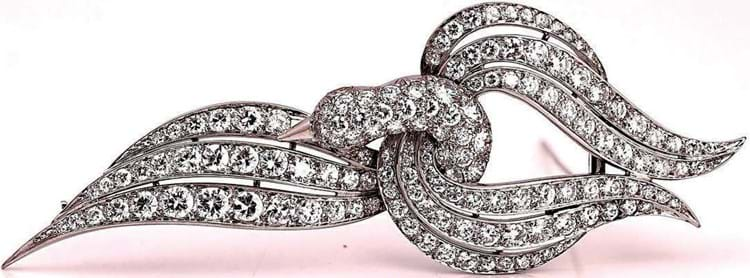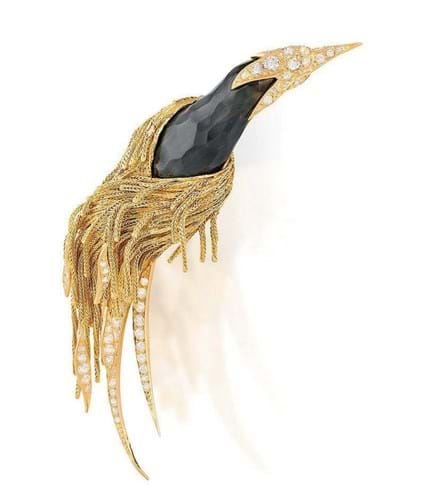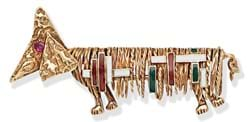This diamond and platinum brooch, offered by Bellmans (22% buyer’s premium) in West Sussex on September 9 probably dates from the 1950s when, working from premises at 43 Avenue de L’Opéra, close to the Place Vendôme, he reached his apogee. Collaborating with fashion designer Jacques Fath, he positioned himself as a couturier of jewellery.
Brooches on avian themes of feathers or wings were a favourite. Conceived in the 40s and 50s in the wake of the Second World War, they symbolised the liberation of France from its oppression by German forces.
The best Sterlé pieces, unconventional in construction and daring in design, give the illusion of movement.
This rare brooch formed as a stylised bird of paradise with yellow coloured diamonds forming eyes and a gold beak is signed Sterlé Paris to the mounts, numbered A5596 and bears French incuse punch marks.
It found plenty of admirers at its £2000-4000 estimate and ultimately sold at £17,000.
Knitted gold
It was following a visit to the Egyptian Museum in Cairo in the early 1950s and his study of ancient Egyptian goldwork that Sterlé came up with the ‘angel wire’ or ‘knitted gold’ technique of twisting and braiding gold wire. The delicate results can be seen to full in the tail feathers of a bird brooch c.1955 offered by Adam’s (25% buyer’s premium) in Dublin on September 14.
It was part of the private collection of ‘a noble Italian lady’ that included pieces from the 1940s and 50s by the great French and Italian ateliers that had been worn by the vendor’s mother.
This brooch was modelled with a hawk’s eye (blue tiger’s eye) body with the articulated gold tassels highlighted with brilliant-cut diamonds, some of them of a yellow hue. It is signed Sterlé Paris and marked with the number 7.558. It went comfortably over its guide of €12,000-18,000 to bring €27,000 (£24,500).
It was in 1955 that Sterlé, a poor businessman for a man from a banking family, began to have his first financial difficulties. The launch of two perfumes was a financial disaster as was the later opening of a boutique. In 1976 he was required to liquidate the company, with all stock being purchased by Chaumet.
Bulgari bracelet
From the same collection was a retro coiled gold, sapphire and diamond Tubogas bracelet by Bulgari from the 1940s that had an estimate of €10,000-15,000 but was competed to €52,000. The Tubogas shape, formed by wrapping long bands of gold around a wood or copper core debuted in the 1940s, and has since become a signature of the brand.
The origin of its name derives from a clever take on the Italian tubo gas, literally translating as ‘gas tube’. This particular piece is an early variation of the Serpenti Tubogas bracelet which emerged in the 1950s.
It is accompanied by a certificate of authenticity from Amanda Triossi, former curator of the Bulgari Heritage Collection, stating that this bracelet was manufactured for and retailed by Bulgari and dates from the 1940s.
















